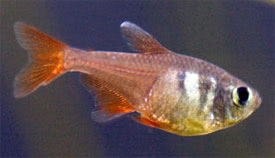
 Magyarul / Hungarian
Magyarul / Hungarian


- Scientific name: Hyphessobrycon flammeus
- Common name: Flame tetra, Red tetra
- Group: Characins
- Habitat: South America; the Upper Amazon in Colombia and Peru.
- Size: 4 cm
- Biotope: Small creeks and river bends with heavy vegetation
- Social behavior: A peaceful, schooling fish that can be kept in a community tank. These fish must be kept in groups of at least six individuals. They do poorly if kept in smaller numbers. Do not combine with fin-nipping fish. An easily frightened fish.
- Diet: Flake, live, insect larvae, Brine Shrimp, Tubifex. Requires varied diet.
- Breeding: Quite easy
- Tank: Minimum 65 litres
- Population: 7 fish for 75 litres
- Decoration: The tank should be well-planted and arranged in dark colors. Provide a cover of floating plants to help mute the lighting. Leave open spaces for swimming and provide hiding places. This fish prefers peat filtration.
- Temperature: 23-26°C
- pH: 6,5-7,2.
- Hardness: 5,6-11,2 NK°
- Lifespan: 4-5 years
Description: The body is deep and disc-shaped. The back is orange to brown and the belly is the same. The body color is pinkish violet to orange and in reflected light, purple. The upper half of the iris is red. Just behind the gill cover is a bright red spot from which this fish gets its name. The male's dorsal fin is sickle-shape and black, pink, purple, and white in color. His anal fin is white. The female's dorsal fin is not as elongated, has the same colors. Its anal fin is smaller with less white color. The back is more high-arched with older individuals. the other fins are pink to gray.
Males are more colorful and have more elaborate fins.
The breeding is difficult, because females often do not respond to mating attempts of males. Eggs are laid in floating plants and some fall to the bottom. Remove parents after eggs are laid. Fry hatch after 2-3 days and are free-swimming after 2-4 more. The fry are hard to raise and must be kept under a constant regime of regular, partial water changes. Start feeding with small live and crushed dry foods.


























